Blog, Network Cabling
What is RJ45 Connector? An Ultimate Guide (2024)
Table of contents
- What is RJ45?
- What is RJ45 Connector
- RJ45 Connector Components
- RJ45 Connector Pinout
- RJ45 Connector Standards
- Advantages and Disadvantages of RJ45 Connectors
- RJ45 Connector Uses and Applications
- RJ45 Color Code
- RJ45 Connector Types
- How to choose the best RJ45 connector?
- What is RJ45 Cable
- How to Crimp RJ45 Connector
- FAQ
- Conclusion
Look at the picture below. Does it look familiar? The RJ45 connector is often seen in our daily lives. It helps connect our computer to the Ethernet smoothly. However, many people may not know it very well. So, what is An RJ45 Connector? Follow me to understand it.

What is RJ45?
RJ45 stands for Registered Jack45, a standardized connector type used for network and telephone connections. It is most commonly used in RJ45 connectors. You may know RJ11 or RJ12, with the “45” being the connector’s identification number, distinguishing it from other connector types.
What is RJ45 Connector
RJ45 is the most commonly used Ethernet connector. It connects one network device (e.g., PC) to another (e.g., switches and routers). It is made of transparent plastic with 8 gold pins, also known as a “crystal header” because of its crystal clarity.
RJ45 Connector Components
The RJ45 connector consists of several key components, as shown below:
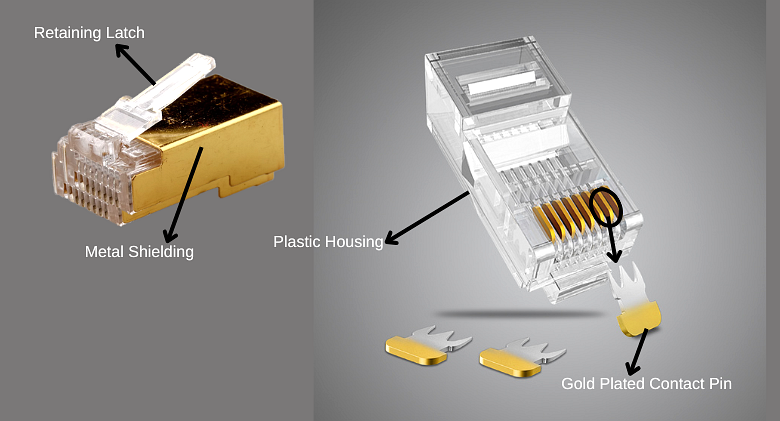
RJ45 Connector Pinout
The eight pins of the RJ45 connector are generally made of gold-plated or nickel-plated copper, which has good electrical conductivity. The plating can resist oxidation, improve corrosion and wear resistance, and enhance the conductivity, thus enhancing the connector’s performance and service life. It is worth noting that the eight pins in the communication assume the role of a specific, as shown in the figure below.
| Pin number | Pin name | Function |
| 1 | TX+ | Transmission data + |
| 2 | TX- | Transmission data – |
| 3 | RX+ | Receive data+ |
| 4 | NC | Unused |
| 5 | NC | Unused |
| 6 | RX- | Receive data- |
| 7 | NC | Unused |
| 8 | NC | Unused |
RJ45 Connector Standards
There are several standards for RJ45 connectors, which are applicable depending on their usage. These applicable standards are briefly summarized below:
- ANSI/TIA 1096-A covers the basic physical dimensions, mechanical characteristics, and contact requirements for RJ45 devices.
- T568A and T568B cover RJ45 wiring and pinouts.
- IEEE 802.3at, 802.3af, and 802.3bt cover various Power over Ethernet (PoE) standards for RJ45 connectors capable of supplying current to end devices.
- IEEE 1394 defines the data interface bus structure used with the RJ45.
Advantages and Disadvantages of RJ45 Connectors
Advantages
- Reliability: It provides a stable and secure connection, ensuring consistent data transmission with minimal interference or signal loss.
- Speed: These connectors, like 10 Gigabit and 40 Gigabit Ethernet, support high-speed data transfer.
- Compatibility: RJ45 connectors are widely used and standardized, making them compatible with various devices and networking equipment.
- Using Friendly: The structure of RJ45 connectors makes them user-friendly for both professional installers and ordinary users.
- Cost-Effective: RJ45 connectors and Ethernet cables are generally affordable.
Disadvantages
- Susceptibility to Damage: Ethernet cables and connectors can be susceptible to physical damage, such as bending or crushing, impairing network performance.
- Compatibility: RJ45 is incompatible with other connectors, leading to compatibility issues. Different cable categories also require different RJ45 connectors.
- Installation Complexity: While crimping RJ45 connectors is not overly burdensome, it requires specific tools and a basic understanding of wiring standards, which can be difficult for some users.
RJ45 Connector Uses and Applications
The following are the main functions of RJ45 connector:
- Transmission of data: When multiple devices are connected, bi-directional data transmission can be carried out through RJ-45.
- Connecting network devices: RJ-45 connects computers, switches, and other devices.
- Ensure network performance and stability: A good RJ45 connector, made of good materials, can maintain network stability and improve network data transmission performance.
- Provide the required network rate: RJ45 supports different rates of data transmission. You can choose different levels of connectors according to your actual needs.
RJ45 Color Code
There are two wiring standards for RJ45 connectors: T568A and T568B. The standards are different; the cable pins are arranged in various colors but have the same number of wires and colors.
T-568A: RJ45 Color code and pin arrangement

The T568A cabling standard was commonly used in the past, but now, T568B is more widely used. The main advantage of the T568A wiring standard over the T568B is that it is backward compatible with one and two-pair USOC wiring schemes.
T-568B: RJ45 color codes and pinouts
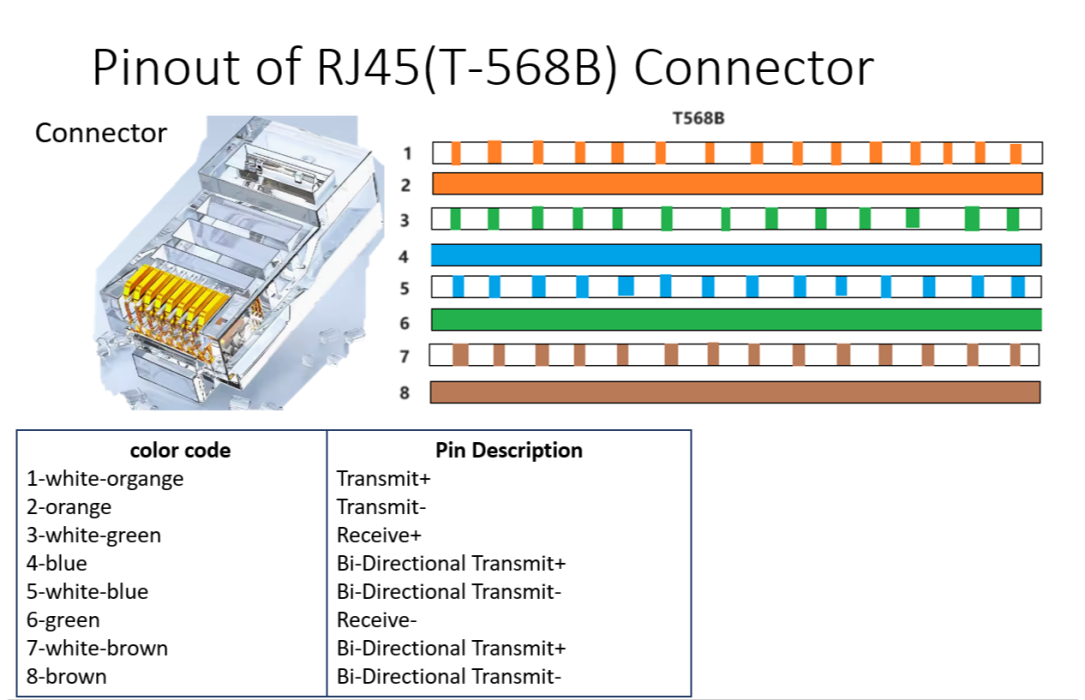
The T568B standard is the most widely used cabling standard today because it effectively isolates signals and provides better noise protection. Compared to T568A, T568B is backward compatible with only one pair of USOC wiring schemes.
When terminating Ethernet cables, the RJ45 connector’s decision on which color code standard to use will depend on individual design requirements and whether a straight-through or crossover cable is used. Straight-through cables (patch cords) have the same wiring standard at both ends and connect different network devices. Crossover cables, on the other hand, connect the same type of network equipment by using T568A at one end and T568B at the other.
RJ45 Connector Types
1. Regular and Pass-through RJ45 connectors
Standard connectors are non-straight-through connectors. Pass-through connectors allow the eight-colored copper wires inside the cable to pass through the connector, making them more accessible and aligned when making Ethernet cables.
When making Ethernet cables with standard connectors, stripped and sorted cables must be cut flat to the right length and put into the standard connector. Still, in this process, it is easy to cut the wires too short and then re-strip, sort, or cut them too long and then pull them out again and cut them short. Therefore, pass-through connectors are good at avoiding these problems when terminating Ethernet cables with standard connectors.
2. Shielded and Unshielded RJ45 Connectors
Standard RJ45 or unshielded connectors are the most common type of connector in most Ethernet cables. They have plastic housing, are lightweight, and are easy to install, making them an economical choice for home or small office networks.
Shielded RJ45 connectors, on the other hand, usually have a metal shield to avoid excessive electromagnetic interference (EMI). Nickel is a common material used in metal shields. These connectors are designed for use in environments with high levels of EMI. They help protect the data signals traveling over the cable and ensure uninterrupted network performance.
Note: Shielded RJ45 connectors are typically paired with shielded Ethernet cables for optimal performance. Choose a standard connector if you use a UTP cable or a shielded RJ45 connector if the cable is STP.
3. Standard and Toolless RJ45 Connectors
Standard RJ45 connectors require specialized tools, such as crimping pliers, to terminate Ethernet cables. Toolless RJ45 connectors do not require crimping tools to terminate Ethernet. This toolless RJ45 connector is also reusable and is ideal for on-site and quick termination in emergencies.
How to choose the best RJ45 connector?
1. Look at the appearance
A good RJ45 connector usually looks bright, clear, smooth, and free of impurities and plastic burrs.RJ45 connectors are not always clear and crystal-like, so don’t be surprised if you see a black-grey or blue connector.
In addition, there are metal shielding layers, which are better, but they will also be more expensive. Gold and yellow bright plating are the best, and white and yellow nickel plating is considered good.
2. Listen to the sound
If you have a package of newly purchased connectors, try to shake it and then listen to the sound; the more crisp, proving that the connector density and purity are higher. If the sound is dull, its quality is poor.
3. Test the fixing latch
A well-fixed latch can be folded more than 180 degrees several times and restored to its original state with good elasticity.
4. Check the 8 contact pins
In the international standard IEC 60603, the RJ45 connector should have 50μ gold-plated contact pins. The gold plating on the stylus because it is one of the best electrical conductors. 50μ gold-plated stylus is designed to avoid data loss and corrosion, so you should pay attention to the thickness of the gold plating to get better performance.
More importantly, there are two-phase contacts and three-phase contacts. Three-phase contacts can be more stable and help secure the cable wires tightly.
Practical shopping advice: for RJ45 connector metal contacts
We can also take a small blade with us during the actual purchase. The role of the blade has two:
One is to use the blade to scrape the metal contact piece part of the crystal head if the copper on top can be easily bracketed off, and inside, the color is also relatively dark; it is undoubtedly false; on the contrary, the surface of the copper plating is complex to scrape off, even if there is a little off the part, observe the inside of the exposed metal contacts are also bright, it is a suitable connector;
Another role is to try to use the tip of the knife to pry the metal terminals; generally speaking, good crystal head connections are labor-solid and difficult to pry out, while counterfeit crystal head production work is not standard and may gently dial down.
What is RJ45 Cable
RJ45 cables, or Ethernet cables, have RJ45 connectors attached to both ends. They are usually wrapped in four twisted wires with an outer PVC jacket. Depending on the cable category, a cross-bone or fiber optic strand is usually inside.
There are several categories of RJ45 cables: cat5, cat5e, cat6, cat6e, cat7, and cat8 (you can see the differences in our previous articles, with links to the corresponding articles at the end of this article). Generally speaking, the higher the category number, the greater the data transfer rate of the cable.RJ45 cables connect computers to routers and computers to RJ45 ports.
-
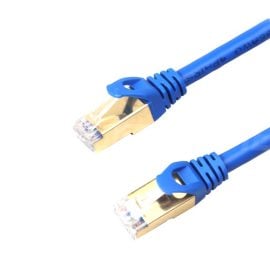 Cat7 Snagless Shielded (SFTP) Ethernet Network Patch Cable, PVC, BluePrice range: US$ 2.20 through US$ 25.80 (Excl. VAT)
Cat7 Snagless Shielded (SFTP) Ethernet Network Patch Cable, PVC, BluePrice range: US$ 2.20 through US$ 25.80 (Excl. VAT) -
 Cat8 Snagless Shielded (SFTP) 25G/40GBase-T Ethernet Network Patch Cable, PVC, BlackPrice range: US$ 2.25 through US$ 28.80 (Excl. VAT)
Cat8 Snagless Shielded (SFTP) 25G/40GBase-T Ethernet Network Patch Cable, PVC, BlackPrice range: US$ 2.25 through US$ 28.80 (Excl. VAT) -
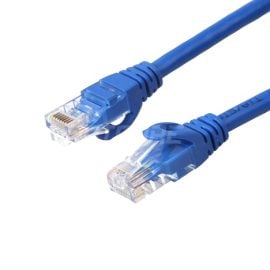 Cat6 Ethernet Network Patch Cable, Snagless Unshielded (UTP), PVC, BluePrice range: US$ 0.85 through US$ 13.10 (Excl. VAT)
Cat6 Ethernet Network Patch Cable, Snagless Unshielded (UTP), PVC, BluePrice range: US$ 0.85 through US$ 13.10 (Excl. VAT)
How to Crimp RJ45 Connector
First, prepare a unique crimping tool and then connect the RJ45 connector to the Ethernet cable. By crimping, you can ensure that the RJ45 cable is not affected during plugging and unplugging but also keep the cable free from electrical or moisture interference. The following are the specific crimping steps:
Step 1: Prepare the Ethernet cable
Select the desired cable category and cut the target length of the cable. Then, carefully strip off the outer 1-2 inches of the plastic protective jacket, avoiding damaging the internal wires. Then, unravel and organize the twisted-pair wires, putting the 8 wires in order according to the wiring standards. Finally, the wires should be straightened, even in alignment, and then wire cutters should be used to trim the level to 0.5 inches from the sheath.

Step 2: Crimp it to the cable
It will be ready to insert the cable into the RJ45 connector and push it to the top of the connector. Then, again, to see and check the wire sequence, use the crimping tool to crimp the connector, tightening the squeeze to ensure the formation of a connection.

Step 3: Test whether the crimping is successful
First, use a cable tester to confirm that the wiring is correct. Then, connect the RJ45 cable to our computer and use the computer’s network diagnostic tools to see if the connection meets the network performance requirements.
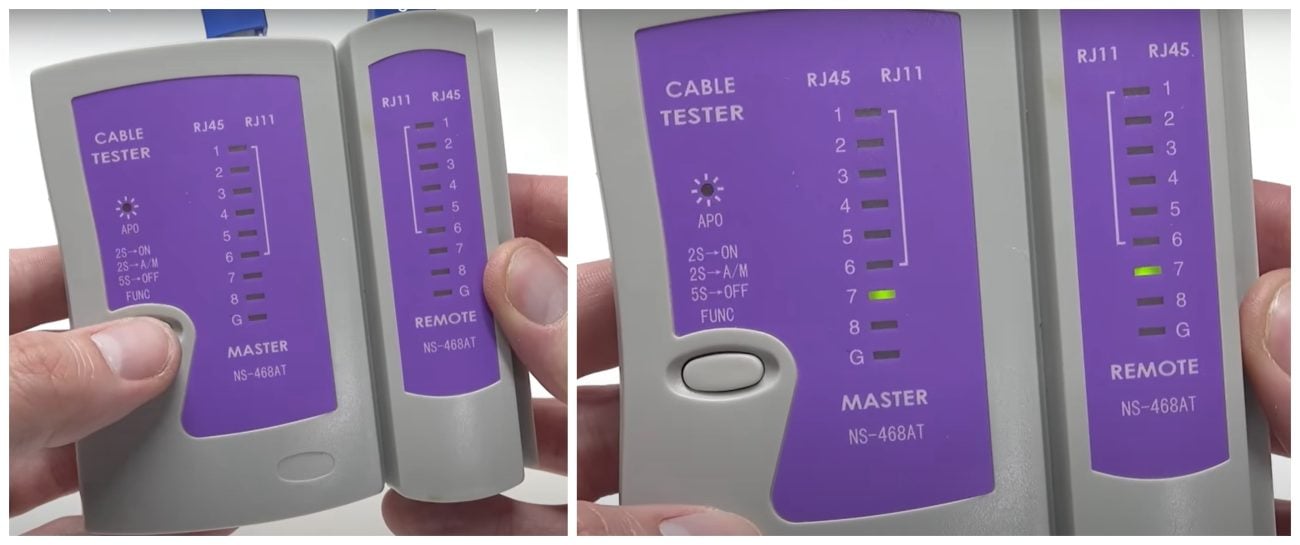
FAQ
Q. What is an RJ45 connector?
A. An RJ45 connector is a standard connector for Ethernet networks. It typically connects network cables to devices such as computers, routers, switches, and other network equipment. The connector has 8 metal pins that plug into an RJ45 port.
Q. I have a Cat6 cable and an RJ45 connector. What tools do I need to buy to terminate the RJ45 connector on the cable?
A. Before crimping, you will need wire strippers; during the crimping process, you must buy an RJ45 crimper. Friendly suggests you purchase multi-functional crimping pliers to store them well and not spend too much time picking the right tool.
Q. Is there a difference between RJ45 connectors for different cable standards?
A. There is a difference; the different cable categories determine whether there is a shield of the cable that should be selected with a metal shield of the RJ45 connector. The standard RJ45 connector is plastic, which may be challenging to meet the performance and anti-interference requirements.
Q. What are the common problems with RJ45 connectors?
A. Common problems with RJ45 connectors include:
- Poor contact: may result in an unstable network connection or failure to connect. Check whether the connector is appropriately crimped and firmly inserted.
- Short or open circuit: Incorrect wiring sequence or damaged cables may cause the network to fail to transmit signals. A tester is required to check the wiring.
- Oxidation or corrosion: The connectors may oxidize after prolonged use, affecting the contact. Check and clean the connector contacts regularly.
Q. How to identify the RJ45 connector and RJ45 port?
A. The RJ45 connector is at both ends of the cable, usually in a transparent plastic housing with metal contacts. The RJ45 port is the interface at the device end, traditionally embedded in the device or on the wall, with corresponding 8 metal contacts shaped to match the connector. When the connector is inserted into the port, you usually hear a ‘click’ sound, indicating a successful connection.
Q. What is the difference between RJ45 and other connectors?
A. RJ45 connectors are mainly used for Ethernet connections, while other types of connectors (e.g. RJ11, USB, HDMI, etc.) are used for different applications.RJ11 is usually used for phone lines, USB for data transfer and power, and HDMI for high-definition audio/video transmission.RJ45 connectors have 8 pins to support higher data transfer rates, while RJ11 usually only has 4 or 6 pins.
Q. How do I maintain the RJ45 connector?
A. Ways to maintain the RJ45 connector include:
- Periodic inspection: Inspect the connector periodically for wear, oxidation, or residues.
- Cleaning: Gently clean the plugs and sockets with a dust-free cloth and a suitable cleaning agent, avoiding the use of highly corrosive chemicals.
- Avoid excessive pulling: When plugging and unplugging cables, hold the connector rather than the cable itself to prevent pulling from causing poor contact. When unplugging the connector, you need to press the Latch.
Q. What network speeds and standards are supported by RJ45 connectors?
A. The RJ45 connector supports a variety of Ethernet standards, including:
- 10BASE-T (basic transmission speed of 10 Mbps)
- 100BASE-TX (Fast Ethernet with a transmission speed of 100 Mbps)
- 1000BASE-T (Gigabit Ethernet at 1 Gbps)
- 10GBASE-T (10 Gigabit Ethernet at 10 Gbps)
- 40GBASE-T (40 Gigabit Ethernet at 40 Gbps)
Support for these standards usually depends on the cable category (e.g., Cat5, Cat5e, Cat6, Cat6a, Cat7, Cat8, etc.).
Conclusion
Making RJ45 cables with RJ45 connectors and crimping tools is simple, and the resulting RJ45 cables are an important part of our access to Ethernet. A good RJ45 connector is critical to an Ethernet cable‘s performance and longevity, so it must be chosen carefully. RJ45 connectors are small and compact and available in various types and with various applicable standards.
Read more
- Cat5, Cat5e, Cat6, Cat6a, Cat7, Cat7a vs Cat8 Ethernet Cable, What is the difference?
- Do you know the PoE standards and parameters?
- Will PoE over Cat6 cable slow down network speed?








Lo que no veo es aclarar que para los Patch Cords no puede ni debe usarse cable UTP o STP de conductor sólido, porque carece de la flexibilidad necesaria. Lo ideal es usar Patch Cords certificados en fábrica para garantizar la confiabilidad de la conexión.